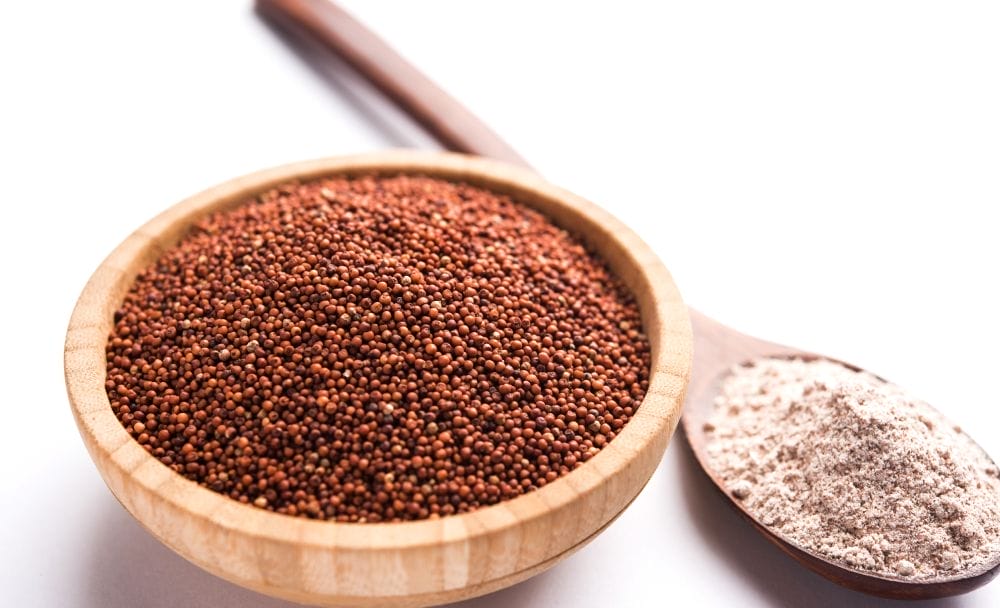
Ragi is a nutritious grain consumed for centuries in various parts of the world, particularly in Africa and Asia. It is also called finger millet and scientifically, it is called Eleusine coracana L. It is consumed in a variety of forms, such as roti made from ragi flour, dumpling, and porridge, and is gaining popularity because of its functional components, which include slowly digestible starch and resistant starch, exceptional amounts of calcium, as well as its great nutritional value, and numerous ragi benefits. [1] In this article, we will try to understand the nutritional composition of ragi and delve into twelve amazing ragi java benefits associated with its consumption.
What is the nutritional value of Ragi?
Ragi is rich in essential nutrients, making it a valuable addition to a balanced diet. Here is a breakdown of the nutritional composition of 100 grams of ragi flour:
| Protein (g) | 7.72 |
| Fats (g) | 1.53 |
| Carbohydrates (g) | 72.64 |
| Ash (g) | 2.65 |
| Fiber (g) | 3.66 |
| Energy (Kcal) | 3367 |
| Ca (mg) | 3508 |
| Fe (mg) | 3.99 |
| Thiamin (mg) | 0.421 |
| Niacin (mg) | 0.1911 |
| Riboflavin (mg) | 1.1 |
12 Amazing Benefits of Ragi
1. Manages Diabetes:
Ragi has a low glycemic index, which means it releases glucose slowly into the bloodstream, preventing sudden spikes in blood sugar levels. This makes ragi flour an excellent grain choice for individuals suffering from diabetes or those who wish to regulate their blood sugar levels. [2]
2. Reduces Cholesterol:
Ragi benefits include its ability to lower bad cholesterol (LDL) levels and increase good cholesterol (HDL) levels, thereby reducing the risk of cardiovascular diseases. [2]
3. Enhances Digestive Health:
The dietary fiber in ragi malt benefits and maintains a healthy digestive system and prevents constipation [3]. It has been seen that fermented finger millet drinks also act as a natural probiotic treatment for diarrhea. [2]
4. Prevents Anemia:
The iron content in ragi malt benefits in the production of red blood cells, and feeding children finger millet-based foods have shown an improvement in hemoglobin status. [2]
5. Promotes Weight Loss:
The ragi flour benefits include its ability to be a resistant starch that leads to reduced digestible energy and hence a reduced calorie density. Thus it is beneficial for individuals with concerns about obesity. [2]
6. Anti-oxidative property:
The presence of antioxidants in ragi malt benefits the human body as it helps fight free radicals and oxidative stress, promoting several health benefits including healthy and glowing skin and preventing premature aging. [3]
7. Wound healing process:
The intake of ragi flour aids nerve growth factor production and wound healing parameters leading to the hastening of the dermal wound healing process. [3]
8. Prevention of colon cancer:
Being high in fiber, ragi flour benefits include helping with delayed nutrient absorption and providing fermentable carbohydrates for colonic bacteria, which lowers the risk of certain types of cancers such as colon cancer. [3]
9. Regulates Blood cholesterol and improves cardiovascular health:
Ragi flour benefits include the ability to trap fatty substances in the gastrointestinal tract; thus, consuming ragi flour can help reduce blood cholesterol levels and lower the risk of heart disease. [3]
10. Supports Bone Health:

Ragi’s rich calcium content, combined with other essential minerals like phosphorus, alkaline phosphatase, and calcium, helps maintain healthy bones preventing the risk of osteoporosis and especially in premenopausal women. [4]
11. A healthy choice for vegans:
Ragi is an excellent choice for vegans as it is packed with several necessary nutrients. [5]
12. Improves Mental Health:
Ragi contains nutrients that help with mental relaxation, regulate mood, and promote well-being. [5]
FAQs
1. How do the various nutrients in Ragi help with multiple functions?
Ragi is extremely rich in a variety of nutrients:
Carbohydrates: Ragi is predominantly composed of complex carbohydrates that provide a sustained release of energy, making it an excellent food for athletes and individuals with high energy requirements.
Fiber: Ragi atta benefits make it an excellent source of dietary fiber that aids digestion, helps regulate blood sugar levels, and promotes satiety, making it beneficial for weight management.
Protein: Ragi atta benefits are furthered because it is a good source of plant-based protein and provides vital amino acids needed for the growth, repair, and maintenance of body tissues.
Fat: Ragi is low in fat, mainly consisting of unsaturated fats, and is considered healthy.
Calcium: Ragi benefits are also enhanced because it is rich in calcium, essential for maintaining strong bones and teeth, and ragi is particularly beneficial for individuals who follow a dairy-free or lactose-intolerant diet.
Iron: Ragi is an excellent source of iron, which plays a crucial role in producing red blood cells, helping prevent anemia, and promoting healthy blood circulation.
Vitamin C: Ragi contains a small amount of vitamin C, a potent antioxidant that supports the immune system and aids in the absorption of iron from plant-based sources.
B Vitamins: Ragi benefits are furthered as they are rich in various B vitamins, including thiamine (B1), riboflavin (B2), niacin (B3), and vitamin B6. These essential vitamins play a crucial role in energy metabolism, brain function, and healthy skin and hair maintenance.
2. How can Ragi be incorporated into your diet?
Ragi can be consumed in various forms, including whole grain, ragi flour, flakes, or malted form. It can be used to prepare multiple dishes such as porridge, roti, dosa, idli, cookies, and bread. Ragi flour can also be added to smoothies and baked goods, or can be used as thickening agent in soups and gravies.
3. How is ragi relevant in Ayurvedic science?
According to Ayurveda, ragi java benefits are legendary as it has an Ama (toxin) reducing property that is good for cholesterol management. Eating Ragi flakes for breakfast and Ragi flour chapatis is suitable for weight management due to its high fiber content. You can also apply Ragi flour paste with milk on the face to eliminate wrinkles.
Conclusion
With its exceptional nutritional composition and numerous health benefits, Ragi is undoubtedly a super-food worth incorporating into your diet. From managing diabetes to supporting bone health and boosting immunity, ragi offers many advantages. Embrace the goodness of this ancient grain and explore its versatility in your culinary creations for a healthier and more nourished lifestyle.
Disclaimer: This article is written from a health and wellness perspective and is not medical advice. Kindly seek the help of a certified medical practitioner before initiating any treatment.
References:
- RAGI, A BOON TO NUTRITIONAL SECURITY
- Finger Millet (Ragi, Eleusine coracana L.). A Review of Its Nutritional Properties, Processing, and Plausible Health Benefits
- Health benefits of finger millet (Eleusine coracana L.) polyphenols and dietary fiber: a review
- Effectiveness of Physical Activity and Finger Millet-Based Food Supplement on Biochemical Parameters and Bone Mineral Density among Premenopausal Women
- Finger millet (Eleusine coracana (L.) Gaertn: A power house of health benefiting nutrients, a review


















